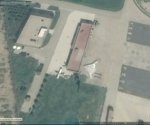Not disinformation per se, but probably a product of the enthusiast community based on published patents and academic papers, which may or may not have much to do with H-20. I'd pay more attention to the flying wing models that have appeared at PLAAF's RCS testing facility. They have a much higher chance of being connected to the H-20 than a model presented by a company known for flight simulators.
Anyway, I don't know the origin of that silver model in your image. I'd like to know the context: who's behind it, where it was shown, etc. I guess it's not the model I'm interested in per se, but the source of its unique layout. Who proposed it and for what purpose? Was it from an institution affiliated with AVIC and/or was it just an academic exercise done to advertise in-house design expertise? I'm not saying that there is no chance that it's related to the H-20, but I'm skeptical.
Who knows, the J-20 turned out to be exactly the same as depicted in one of the earliest artist impressions. We had known what it looked like all along, but we just didn't know it at the time.
I certainly agree that the model that the people were holding is likely not official in any capacity, and absolutely should not be viewed as the likely final configuration of H-20.
However the wind tunnel model is slightly different.
IMO, until we have a clear source of the wind tunnel model images today, I am tempted to say that the wind tunnel model may depict one (of likely many) considered/studied configurations for the H-20 -- but at the same time I would be very surprised if the real H-20 is the exact same as the wind tunnel model, as getting that level of detailed confirmation for such an important aircraft would be unprecedented.
Overall, my view is that for the last couple of years there have been enough indicators towards the "flying wing with folding V tails" idea that I think at the minimum such a configuration was likely at least studied and considered for the project that would become H-20, for it to eventually filter through to the public in this way.
But even then, there are many specific configurations for a "flying wing with folding V tails" to be arranged (think size of the aircraft, trailing and leading edge geometries, inlet arrangement, location and size of V tails etc) -- and the final product might not have that sort of configuration anyway.




